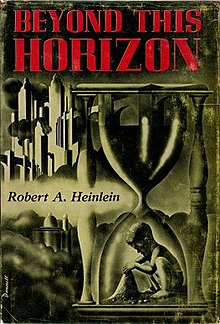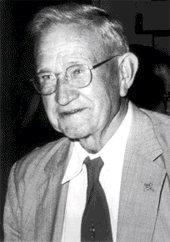
Edward Elmer Smith was an American food engineer and science-fiction author, best known for the Lensman and Skylark series. He is sometimes called the father of space opera.

John Wood Campbell Jr. was an American science fiction writer and editor. He was editor of Astounding Science Fiction from late 1937 until his death and was part of the Golden Age of Science Fiction. Campbell wrote super-science space opera under his own name and stories under his primary pseudonym, Don A. Stuart. Campbell also used the pen names Karl Van Kampen and Arthur McCann. His novella Who Goes There? was adapted as the films The Thing from Another World (1951), The Thing (1982), and The Thing (2011).

Robert Anson Heinlein was an American science fiction author, aeronautical engineer, and naval officer. Sometimes called the "dean of science fiction writers", he was among the first to emphasize scientific accuracy in his fiction, and was thus a pioneer of the subgenre of hard science fiction. His published works, both fiction and non-fiction, express admiration for competence and emphasize the value of critical thinking. His plots often posed provocative situations which challenged conventional social mores. His work continues to have an influence on the science-fiction genre, and on modern culture more generally.

The Moon Is a Harsh Mistress is a 1966 science fiction novel by American writer Robert A. Heinlein about a lunar colony's revolt against absentee rule from Earth. The novel illustrates and discusses libertarian ideals. It is respected for its credible presentation of a comprehensively imagined future human society on both the Earth and the Moon.

Methuselah's Children is a science fiction novel by American writer Robert A. Heinlein. Originally serialized in Astounding Science Fiction in the July, August, and September 1941 issues, it was expanded into a full-length novel in 1958. The novel is part of Heinlein's Future History series of stories. It introduces the Howard families, a fictional group of people who achieved long lifespans through selective breeding.
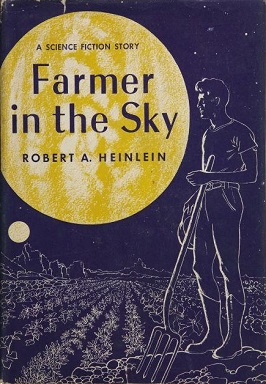
Farmer In The Sky is a 1950 science fiction novel by American writer Robert A. Heinlein about a teenaged boy who emigrates with his family to Jupiter's moon Ganymede, which is in the process of being terraformed. Among Heinlein's juveniles, a condensed version of the novel was published in serial form in Boys' Life magazine, under the title "Satellite Scout". The novel was awarded a Retro Hugo in 2001.
"Blowups Happen" is a 1940 science fiction short story by American writer Robert A. Heinlein. It is one of two stories in which Heinlein, using only public knowledge of nuclear fission, anticipated the actual development of nuclear technology a few years later. The other story is "Solution Unsatisfactory", which is concerned with a nuclear weapon, although it is only a radiological "dirty bomb", not a nuclear explosive device.
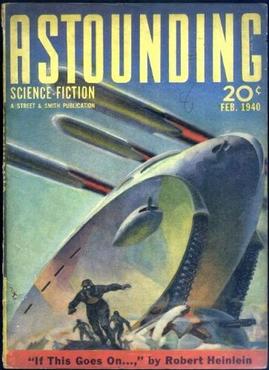
"If This Goes On—" is a science fiction novella by American writer Robert A. Heinlein, first serialized in 1940 in Astounding Science-Fiction and revised and expanded to novel length for inclusion in the 1953 collection Revolt in 2100. The story shows what might happen to Christianity in the United States with mass communications, applied psychology, and a hysterical populace. The story is part of Heinlein's Future History series.

The Man Who Sold the Moon is the title of a 1950 collection of science fiction short stories by American writer Robert A. Heinlein.

Assignment in Eternity, is a collection of four science fiction and science fantasy novellas by American writer Robert A. Heinlein, first published in hardcover by Fantasy Press in 1953. The stories, some of which were revised somewhat from their original magazine publication, were:

Revolt in 2100 is a 1953 science fiction collection by American writer Robert A. Heinlein, part of his Future History series.

Time Enough for Love is a science fiction novel by American writer Robert A. Heinlein, first published in 1973. The book made the shortlist for the Nebula, Hugo and Locus awards for best science fiction novel of that year, although it did not win. It did win a retrospective Libertarian Futurist Society award: the Prometheus Hall of Fame award for 1988.
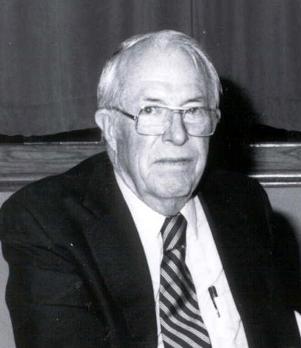
John Stewart Williamson, who wrote as Jack Williamson, was an American science fiction writer, one of several called the "Dean of Science Fiction". He is also credited with one of the first uses of the term genetic engineering. Early in his career he sometimes used the pseudonyms Will Stewart and Nils O. Sonderlund.
In American science fiction of the 1950s and '60s, psionics was a proposed discipline that applied principles of engineering to the study of paranormal or psychic phenomena, such as extrasensory perception, telepathy and psychokinesis. The term is a blend word of psi and the -onics from electronics. The word "psionics" began as, and always remained, a term of art within the science fiction community and—despite the promotional efforts of editor John W. Campbell, Jr.—it never achieved general currency, even among academic parapsychologists. In the years after the term was coined in 1951, it became increasingly evident that no scientific evidence supports the existence of "psionic" abilities.
"Gulf" is a science fiction novella by American writer Robert A. Heinlein, originally published as a serial in the November and December 1949 issues of Astounding Science Fiction and later collected in Assignment in Eternity. It concerns a secret society of geniuses who act to protect humanity. The novel Friday, written in 1982, was loosely a sequel.
The exploration of politics in science fiction is arguably older than the identification of the genre. One of the earliest works of modern science fiction, H. G. Wells’ The Time Machine, is an extrapolation of the class structure of the United Kingdom of his time, an extreme form of social Darwinism; during tens of thousands of years, human beings have evolved into two different species based on their social class.
Social science fiction is a subgenre of science fiction, usually soft science fiction, concerned less with technology/space opera and more with speculation about society. In other words, it "absorbs and discusses anthropology" and speculates about human behavior and interactions.
The Golden Age of Science Fiction, often identified in the United States as the years 1938–1946, was a period in which a number of foundational works of science fiction literature appeared. In the history of science fiction, the Golden Age follows the "pulp era" of the 1920s and 1930s, and precedes New Wave science fiction of the 1960s and 1970s. The 1950s are, in this scheme, a transitional period. Robert Silverberg, who came of age in the 1950s, saw that decade as the true Golden Age. According to historian Adam Roberts, "the phrase Golden Age valorises a particular sort of writing: 'Hard SF', linear narratives, heroes solving problems or countering threats in a space-opera or technological-adventure idiom."
Space warfare is a main theme and central setting of science fiction that can trace its roots back to classical times, and to the "future war" novels of the 19th century. With the Modern Age, directly with franchises as Star Wars and Star Trek, it is considered one of the most popular general sub-genres and themes of science fiction. An interplanetary, or more often an interstellar or intergalactic war, has become a staple plot device. Space warfare, represented in science fiction, has a predominant role, it is a central theme and at the same time it is considered parent, overlapping genre of space opera, military science fiction and Space Western.
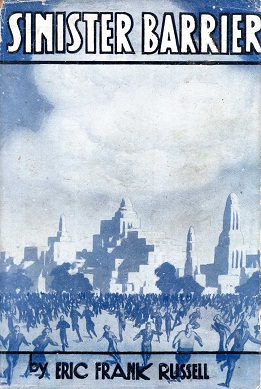
Sinister Barrier is an English-language science fiction novel by British writer Eric Frank Russell. The novel originally appeared in the magazine Unknown in 1939, the first novel to appear in its pages. It was first published in book form in 1943 by The World's Work, Ltd. Russell revised and expanded the book for its first US publication by Fantasy Press in 1948. Most subsequent editions were based on the Fantasy Press version.
